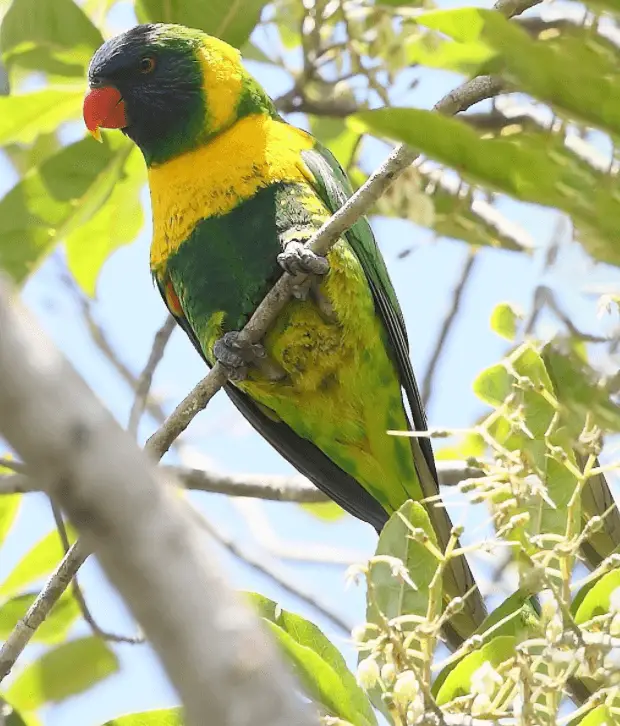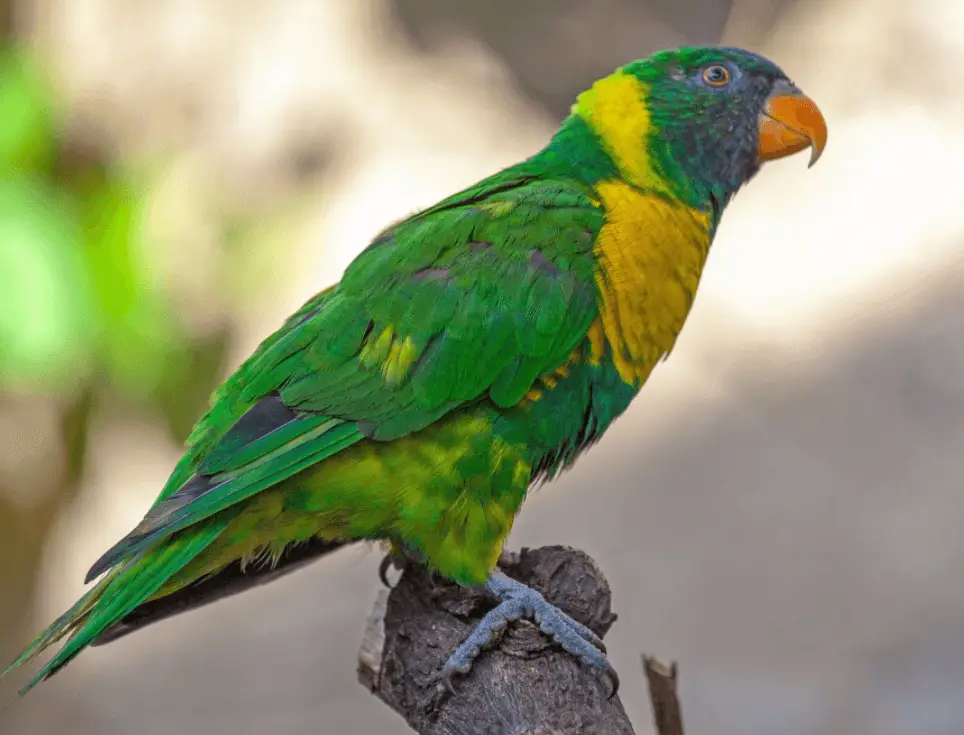Marigold Lorikeet c. 26 cm. Previously regarded as conspecific with T. haematodus (see Taxonomy comments). Compared to the latter has virtually unbarred bright yellow breast, with red flecking,
a large green patch in the center of the belly (can be tinged blue-black) that extends to under tail-coverts, and becomes more like barring on flanks;
thighs yellow with some green barring, some green on the throat, and extensively suffused green on the crown and behind the eye; lacks red bases to mantle feathers. Sexes alike.
Races fortis and flavotectus also have orange-yellow breasts, but the former has less red on the breast and a duller green belly than nominate, while the latter has breasts all pale yellow (sometimes with slight orange suffusion) with fine dark tips, head greener with paler blue areas, belly patch all green, underwing-coverts bright yellow, and lacks any red on the mantle.
Systematics History
Editor’s Note: This article requires further editing work to merge existing content into the appropriate Subspecies sections. Please bear with us while this update takes place.
With one exception, has hitherto been treated as a group of subspecies within the widespread Rainbow Lorikeet T. haematodus complex, but differs in its plain bright yellow breast; and green lower throatband extending to the hind crown. Three subspecies were recognized.

Subspecies
Trichoglossus capistratus fortis Scientific name definitions
Distribution
Trichoglossus capistratus capistratus Scientific name definitions
Distribution
Trichoglossus capistratus flavotectus Scientific name definitions
Distribution
Distribution
Editor’s Note: Additional distribution information for this taxon can be found in the ‘Subspecies’ article above. In the future we will develop a range-wide distribution article.
Habitat
Forested areas, both primary and secondary, including dry woodland on Roti, with a general preference for higher altitudes on Sumba. Recorded to at least 490 m on Romang.
Movement
None known.
Marigold lorikeet, birds, parrot
SOURCE: moonlight view kerala
Diet and Foraging
Few specific dietary data, but presumably similar to T. haematodus and is known to take nectar and pollen from native trees and shrubs, especially Eucalyptus on Timor. Recorded also feeding on the nectar of Erythrina flowers.
Sounds and Vocal Behavior
High-pitched, harsh shrieks, typical of the T. haematodus superspecies and at a similar frequency to T. euteles.
SOURCE: obirds
Breeding
A total of 21 nests were found on Sumba between late Aug and early Oct 1992, all of the cavities in large (mainly deciduous) trees,
sometimes shared with Yellow-crested Cockatoos, and typically 19 m above ground (range 9–29 m), with hole width of 9–17 cm and length of 11–32 cm. No further information.
Marigold lorikeet in captivity
SOURCE: Alex Kantorovich
Conservation Status

Not globally threatened. CITES II. The unquantified population is suspected to be in decline owing to unsustainable levels of exploitation but was considered to be still common on Sumba in the early 1990s, where density estimated at 29 individuals/km² in primary forest and 33 individuals/km² in secondary forest.
Unlikely to be much affected by selective logging. Heavily traded: between 1981, when it was listed on CITES Appendix II, and the mid-2000s, 100,388 wild-caught individuals have been recorded in international trade.
Only very recently discovered (Dec 2004) on the island of Roti, off Timor, were deemed to be uncommon. Race flavotectus is considered to be common on Wetar, but apparently uncommon (and has perhaps declined) on Romang. Occurs in Langgaliru National Park, on Sumba.





















